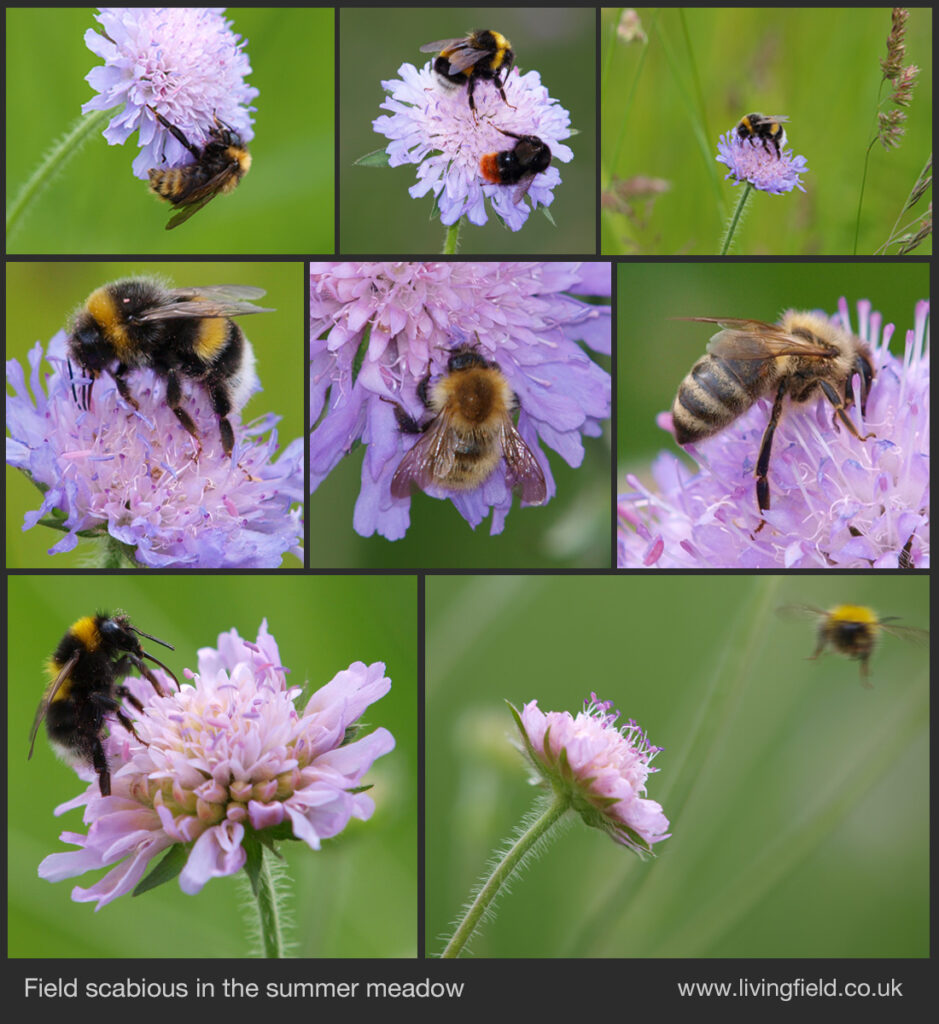
Field scabious flowers in the Living Field garden’s meadow for several months over summer and early autumn.
sustainable croplands

Field scabious flowers in the Living Field garden’s meadow for several months over summer and early autumn.
June 2019 and the various projects based in and around the Living Field are starting to bear. The Farm flew its drone on 5 June to get a photograph of the Vegetable Map of Scotland and at the same time took in the whole of the garden.
The garden was designed so that some parts would remain fixed – the habitats – and other parts would change as new ideas and projects replaced older ones. The fixed parts in the image below are mostly in the right hand (east) section – the meadow, the trees, the hedges and the small pond and ditch, which is just not visible behind the lower hedge.
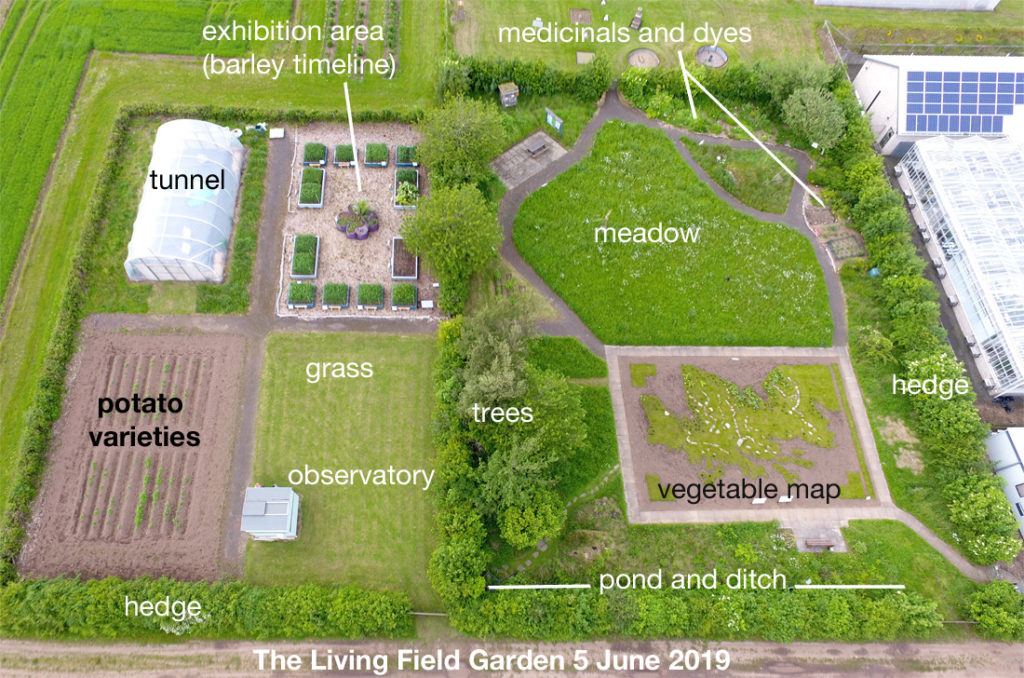
The plots to the north east just inside the hedges have held a small collection of medicinal and dye plants for several years and so are also almost fixed.
The Vegetable Map in the lower right quadrant is placed on the site of the previous arable plot which has grown cereals, roots, vegetables and various legumes for well over ten years, but we decided this year to turn it into something different. The image of the map below has been turned round, with north to the right.
The intention is to keep the shape of the map over time but change the cultivated plants that are being inserted into the fertile regions of the country. This year peas, potato and assorted vegetables will be grown.
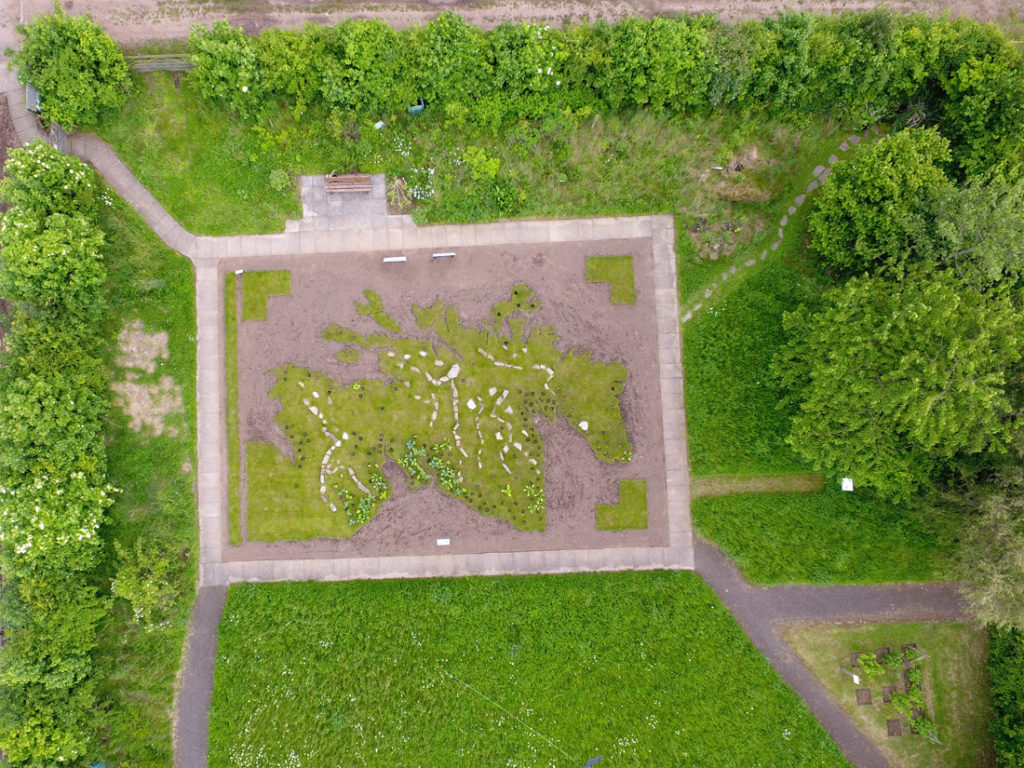
The west garden is split into four plots. The top left one (north west) holds a polytunnel, used for activities when it is raining.
The top right is a exhibition area in which raised beds have been built. A few years ago they were used to contain the forage legume collection (e.g. lucerne, milk vetch, tufted vetch, kidney vetch). After that we had a varied display of vegetables and herbs and now in 2019 they are mainly occupied by the Barley Timeline, an assortment of barley landraces and varieties grown since the 1800s. There are still some herbs retained in the centre bed.
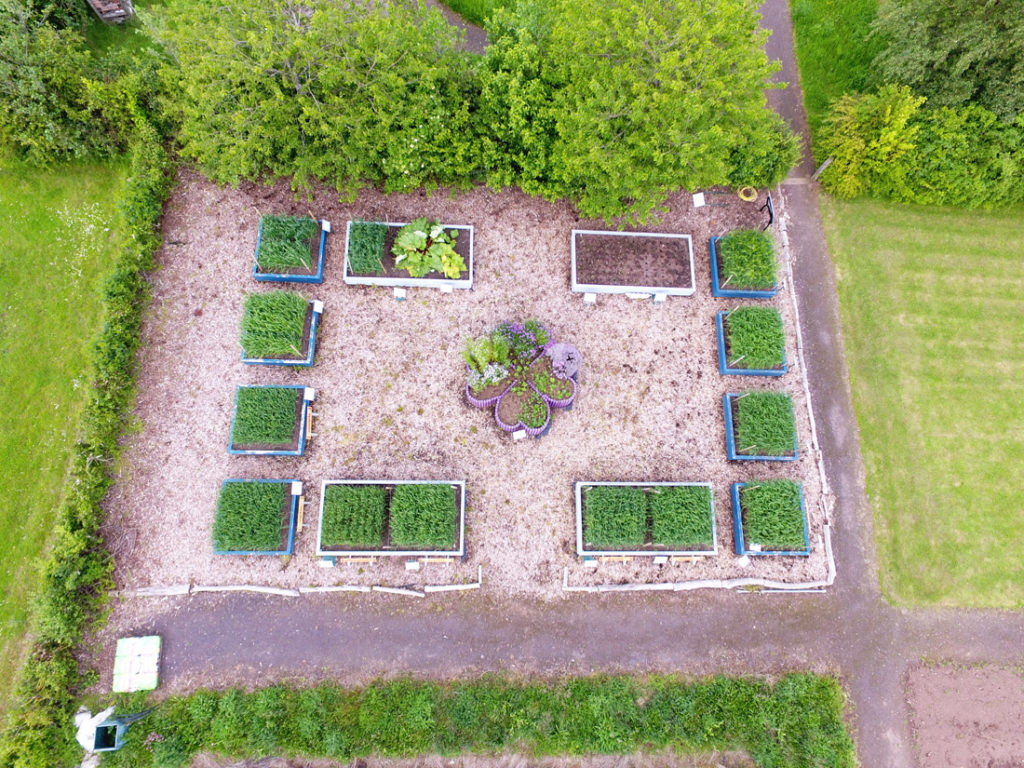
The third quadrant, south east, is down to mown grass, a space for various activities. It becomes a picnic area on open days. It also houses Dundee Astronomical Society’s observatory.
The fourth, in the south west, has had a range of plants grown in it, recently annual mixed ‘grass’ consisting of both traditional grass and broadleaf plants, and now this year a collection of potato varieties, many developed at the Institute.
While the overall garden and its activities are managed by a small group, a wide range of people have been involved since first the ground was drained and levelled in 2004 – see The Making.
The Farm staff do all the hedge cutting and soil cultivation and this year the carting of rocks and laying of turf for the Vegetable Map. The Workshop make the signs, prepare the corn grinder and do whatever needs fixing. Horticulture and glasshouse colleagues help to pot and raise the thousands of plants that go out each year. Science staff, mainly from Ecological Sciences, provide the knowledge of plants, their functions and how to grow them.
What may be surprising is that very little (if any) of the contributions are formally costed. There are no project specs to adhere to. Quite a bit of the effort is given voluntarily, out of hours. This genuine community is what makes the Living Field work.
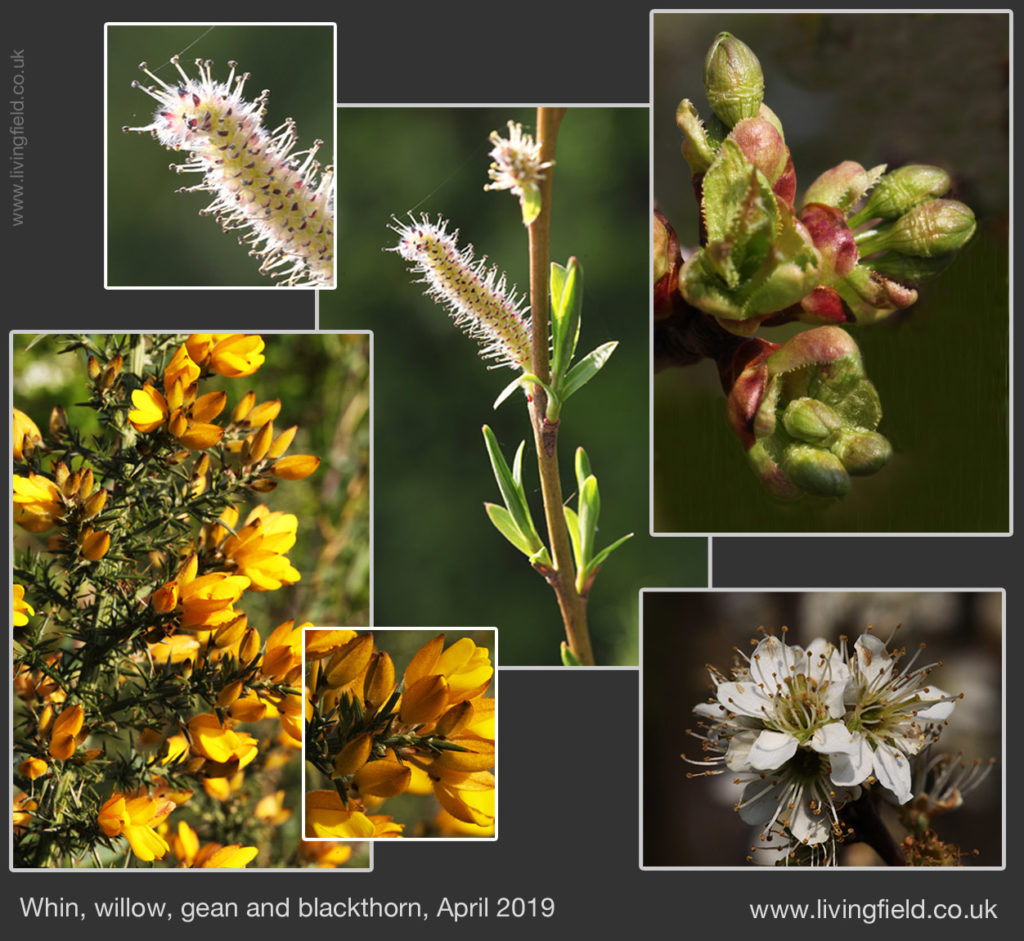
Beginning in April with buds and flowers of the perennials …. follow the seasons here.
The Living Field project has been sharing knowledge of ancient and modern cereal grains for over 10 years [1]. Here we look back at how things evolved from field studies in barley on the Institute’s farms to growing our own range of cereals and finally using bere barley and other flours to make bannocks, bread and biscuits.
The sequence is shown here for bere barley. Seeds are sown, crops are grown. Bere plants support reproductive heads or ears holding grain. Plants are harvested and the grains removed and cleaned. They are ground into meal or flour, then used alone or mixed with other flours to make bread, bannocks and biscuits.
This sequence has sustained people for thousands of years. Today the grain we eat in Scotland, except for oats, is not grown here – the main cereal products from local fields are alcohol and animal feed. But whatever the future of agricultural produce, the grain-based cycle will remain essential to settled existence. In this retrospective, we describe the Living Field’s shared experience of ‘seed to plate’ over the last 10 years.
We began by introducing visitors to the James Hutton Institute’s fields where barley is grown both for experiments and for commercial grain sales. From 2007, the Living Field has been using the farm’s barley to give school parties a first taste of life in the crop.
The larger image above looks down from a barley field at Balruddery farm to the Tay estuary. The school children in the pictures were visiting fields of young barley at Mylnefield farm just above the Tay. This was in May 2007. They walked along the ‘tram lines’ looking at plants and finding ‘minibeasts’ – the first time many of them had been in a crop. They were fascinated with small creatures found crawling on the plants or walking over the soil [2].
The public interest in crops and their ecology in those early visits encouraged us to explore a much wider range of cereal plants than presently grown in commercial agriculture.
So began a small collection of grain crops which were sown, tended and harvested each year in the Living Field Garden [3]. We began in 2010 by growing bere barley from Orkney, black oat, emmer and spelt wheat, alongside modern varieties of barley, oats and bread wheat. Rye and a landrace of bread wheat from the western isles were added later, then several other barley landraces and old varieties [4].
The collection of photographs above shows (top right) a general view of the garden including a tall cereal plot in the middle of the photo, then c’wise from upper right – a barley landrace from Ireland, rye, black oat, emmer wheat, young spelt ear, spratt archer barley and a bread wheat landrace.
By 2011, the Living Field had combined its practical experience on the farm with the collection of ancient and modern grains in the Garden. Gladys Wright and Jackie Thompson had perfected the way to grow all these different species. We now needed a means to demonstrate processing the grain and making food from it.
The harvest from the small plots in the garden was too little to make flour enough for open days, road shows and exhibitions. Additional grain and flour (or meal) was begged or bought from a range of sources, notably Barony Mills in Orkney and ‘Quaker Oats’ in Fife.
The Living Field then bought its own rotary quern for grinding the grain into meal and chaff, which is the name given to the other bits we don’t usually eat, mostly the protective sheathing around the grain and the awns.
Now to make a loaf! Fortunately one of the team, Gillian Banks, was already an experienced bread-maker and after some experimentation turned out tasty loaves made from various mixtures including bere and modern barley, oats, emmer, spelt, wheat, rye …. and more [5]!
The whole chain from sowing seed in the ground to making food could now be demonstrated from first-hand experience. We did this at various open events beginning 2012.
The panel above shows (bottom left, clockwise) – visitors experiencing a range of ancient grains and flours, demonstrating the rotary quern, a sheaf of spelt, making things from sourdough, and a four-panel set showing oat grain in a bag, sieving and sorting meal from chaff and finally bread.
The highlights of our outreach over the years has been LEAF Open Farm Sunday. The Institute is a LEAF innovation Centre [6], so on the first Sunday in June, the farm and science come together to host the event. One of the main attractions is the hub of activity around the Living Field garden, cabins and tunnel. Typically 1000-2000 people visit the hub during the day. We’re mobbed ….. thanks to all!
The essential structure of a successful open day is, firstly, to provide plenty of things to do for young children, to keep them occupied and allow time for older children and grown-ups to talk about what’s on view; and, second, hands-on activity with natural products, things such as living plants, and grain and flour that can be touched, felt and smelled [6].
Group activities are usually located in the garden’s polytunnel, just in case of rain. The panel above shows (lower left c’wise) examples of grain and flour, a ‘tasting’, making things with grain and other natural materials, an activity table for children and their grown-ups, and bags of grain from the garden with young scientist sitting on the rotary quern fascinated by oat grains.
The thread linking exhibits through the years has been bere barley – Scotland’s barley landrace, an attractive plant, easy to grow. Bere as a crop declined in the late 1800s and is now restricted to a few fields in the far north. Like most of the world’s landraces, bere faded in competition with modern crop varieties and production methods. Yet it remains a favourite here. Its story continues [7].
Bere and other barleys were traditionally used to make a flatbead or bannock, either on its own or mixed with oatmeal or peasmeal, but bere meal has many uses when mixed with other flours.
The Living Field has friends and correspondents like Grannie Kate who regularly experiment with different uses of ancient and modern grains. Scones, shortbread, batter, porridge, soups can all include bere as a unique constituent. One of the team regularly adds a a spoon or two of bere meal to their morning’s rolled-oat porridge.
The images above show (top left, c’wise) bere and oat bannocks, a bag of bear meal in Grannie Kate’s kitchen, bere fruit scones and bere shortbread [8].
Following the Living Field’s appearance at a ‘biodiversity day’ run by the Dundee Science Centre in January 2016, we were invited to join the exhibition trail organised in 2016 by the Centre as part of The Crunch [9]. By this time, we could take take the whole process on the road – seed-plant-grain-flour-food.
Gill Banks and Linda Nell, with Lauren Banks and Geoff Squire, ran the grain to plate events at The Crunch venues. One was in a darkened auditorium at the Dundee Science Centre, another at a local community Centre.
The Science Centre suggested we bring some bread made in the usual way from cereal grain and some made from insects. Gill bought various whole insects and flours and made some insect loaves that several of us had a pre-taste of and concluded they tasted just like nice wholesome loaves.
Anyway, the insects went down a treat at the events and started many a conversation of what we eat and what it costs – insects gram for gram need much less energy and cause much less pollution than most other forms of animal rearing.
The panel above shows scenes from the (top right) the January event) and bottom right (The Crunch) both at the Science Centre, then (top left, down) sheaves of spelt and black oat, globs of gluten extracted from wheat by Gill, mixed-flour bread with dried crickets laid on, and (at the bottom) dried insects for cooking or eating and (centre) barley grain.
Through working with artists, the team were able to see the plants they had grown become part of artwork. Jean Duncan for example was able to place grain not just as a food but as essential to the development of farming and human society since the last ice. In her work, grains and plants appear close to circles, barrows, landforms and field systems.
Some extracts from Jean’s creations are shown in the panel above. Various ears, spikelets and grains appear commonly alongside mounds and barrows (example right). At top left, ancient cereal plants are stylised as fans, drawn near the centre of a circular design, used to create a revolving backdrop for an opera. At bottom left, a section of her ‘teaching wheel’ shows a range of cereal species grown in the region since the neolithic [10].
At Open Days, children like drawing things, messing with paint and pencil: better then just looking, it helps to give them a lasting memory of what they saw and touched.
Nearing the end of 2018 and the project will continue its work on bere and other grains, ancient and modern. The Living Field is connecting to the swell of interest in local food and recipes.
Few others can demonstrate the whole chain – not just grain to plate – but from sowing the seed to eating the food and, crucially, saving some grain for the next year’s crop.
The James Hutton Institute has recently been awarded funds for an International Barley Hub. Let’s see what the 2019 season brings!
The idea of ‘insect bread’ always raises interest, even if to some the thought is less than appetising. But insects and bread have a long history together ……
At one time and even now in many places, a bag of flour can have resident insects in the form of weevils. They live and reproduce in it, eat it and recyle it in one form or another (probably best not thought about). They add a little crunchy something to a baked loaf [11].
That’s insect bread ‘by accident’. For several years, and as shown above, Gill and Co have been experimenting with bread made from insect flour mixed with grain flour. The insects tried so far are mainly crickets, raised especially for the purpose (though not by us). Insects as alternatives to fish and meat in European diets is a hot topic now [12].
[1] Geoff Squire and and Gladys Wright developed the ideas around a seed to plate theme not long after the Living Field garden began in 2004.
[2] The Hutton farm staff have been partners in the Living Field since its making in 2004. They manage the crops, drive the tractors and explain what’s going on to visitors.
[3] Gladys Wright and Jackie Thompson grow the Living Field cereals from seed each season. They have been helped by several other people in earlier years, especially Linda Ford.
[4] Thanks to Orkney College and SASA Edinburgh for giving the original seed. The Institute’s barley collection was the source of several landraces and varieties grown in 2015: see Barley landraces and old varieties.
[5] Gillian Banks experiments with bread making and has regularly baked a range of ancient grain loaves and biscuits for open days and road-shows: see Bere and cricket.
[6] Open Farm Sundays have been well supported by Hutton staff – Gladys Wright and Jackie Thompson prepare and run the Living Field ‘space’; other regular contributors to the ancient and modern cereals theme include Gill Banks, Lauren Banks, Linda Nell, Linda Ford, Mark Young and Geoff Squire. Students and family have helped time and again on the stalls and exhibits. For more on LEAF Linking Environment and Farming, see LEAF innovation Centre.
[7] Bere barley and bere meal feature regularly on the Living Field web site, for example see the Bere line – rhymes with hairline, Bere country, and Peasemeal, oatmeal and beremeal.
[8] The Living Field’s correspondent Grannie Kate’s offerings mix bere with other flours, see Bere shortbread, Bere scones, Bere bannocks and Seeded oatcakes with beremeal. Barony Mills in Orkney also has a book of recipes.
[9] The Crunch was a UK-wide series of events held in 2016, coordinated locally by Dundee Science Centre: Gill and Lauren Banks, Linda Nell and Geoff Squire, among others, offered a range of exhibits on themes of grains and bread: see Bere and cricket, The Crunch at Dundee Science Centre. Thanks to DSC for inviting us to take part.
[10] Jean Duncan is an artist who has worked with the Living Field for many years. For examples of her work and links to her wider presence from the neolithic onwards, see Jean Duncan artist.
[11] Geoff reminisces – ‘lived once in a place where the flour bought to bake bread had live-in weevils; you could pick the big ones out, otherwise they got baked.’
[12] Crunchy bread made by Gill Banks from insect flour: photographs and details at Bere and cricket. Later, Gill, Geoff and Linda F found when investigating an infestation of weevils in grain, that insects in bread, whether by design or accident, bring a high-nitrogen (high protein) addition, insects being about 10% N by weight – little nuggets of protein in your low-N loaf!
Contacts: this article, geoff.squire@hutton.ac.uk or geoff.squire@outlook.com; growing the cereals, Gladys Wright has since retired from the Institute. Any enquiries through GS.
A vegetable bounty this year – leaves, flowers and ‘roots’ of all shapes and sizes have appeared in the Living Field Garden. Gladys and Jackie have nurtured a fine array of eatables, which many long term Garden observers say is the best yet, and that’s from a year which has not been ideal for crops.
Here are just some of my favourites (writes Geoff).
This red cabbage (sometimes called blue) matured late and kept well, outside in the shade, for at least a month after being cut. Half was pickled, and sat on a shelf with the others. The rest was eaten as a raw or cooked vegetable.
 The cabbage shown above was cut in half with a big kitchen knife and photographed. It is shown as a ‘reverse image’ to bring out the structure of the folded leaves.
The cabbage shown above was cut in half with a big kitchen knife and photographed. It is shown as a ‘reverse image’ to bring out the structure of the folded leaves.
The cauliflower, below, was football sized and too large to show its halves side by side. One half went the same day as it was cut, eaten as cauliflower cheese – a strong brassica taste with a milder cheddar-type cheese sauce, in this case Mull (but Anster is also good for this), sprinkled with grated parmesan, and then paprika to give it spice and colour.
The other half was cut into small pieces and pickled with wine vinegar, onion seed and peppercorns, to be eaten over the winter. It is now waiting in a jar.
The carrots (below) grew into complex shapes this year. They are not deformed, just natural. Some of this year’s carrots looked like an octopus, orange tentacles clasping the main body. Others reclined languorously on the table top, waiting to be peeled and cut. Still others were more or less straight with lumps in strange places.
But there’s no reprieve whatever the form. Roasted or boiled with herbs, very tasty, real carrot, soon eaten.
The onions looked a bit ragged on harvest, but were unblemished inside their protective leaves. The smell when cut is definitive, to be savoured and remembered. The layers of leaves, filled with winter storage, are distinct, all white near the centre but with red outers towards the edge of the bulb.
The onions that came to our kitchen from the garden this year were all pickled with seeds and spices in wine vinegar. They are also waiting in a jar, next to the cauliflower.
The beet went the same way as the cauliflower – one half pickled, this time in red wine vinegar, the other half eaten. But the revelation for me – not a great fan of beet – was the chunks of it, coated in oil (try cold pressed rapeseed) then roasted in foil and eaten with Maris Piper. What a taste – fresh cooked beet like this is up there among the great vegetables of all time. Thanks to those pioneers of crop selection who managed to get these red chunks out of wild sea beet.
[more vegetables cut in half to follow, as they are harvested later in the year … ]
You can see more of Gladys and Jackie’s efforts on display at Open Farm Sunday 2017 and at Vegetables on the Garden pages.
Unremitting wet since solstice-time in late June. The field scabious Knautia arvensis offers bee-food en masse for months in most years, and in June the mauve flowers promised a fine show, already thick with bumble bees.
Since then they have been thrashed by the heavy rain and wind and grasses now dominate the meadow. Yet on the rare sunny afternoon, the insects take their feast on the Garden’s wild plants.
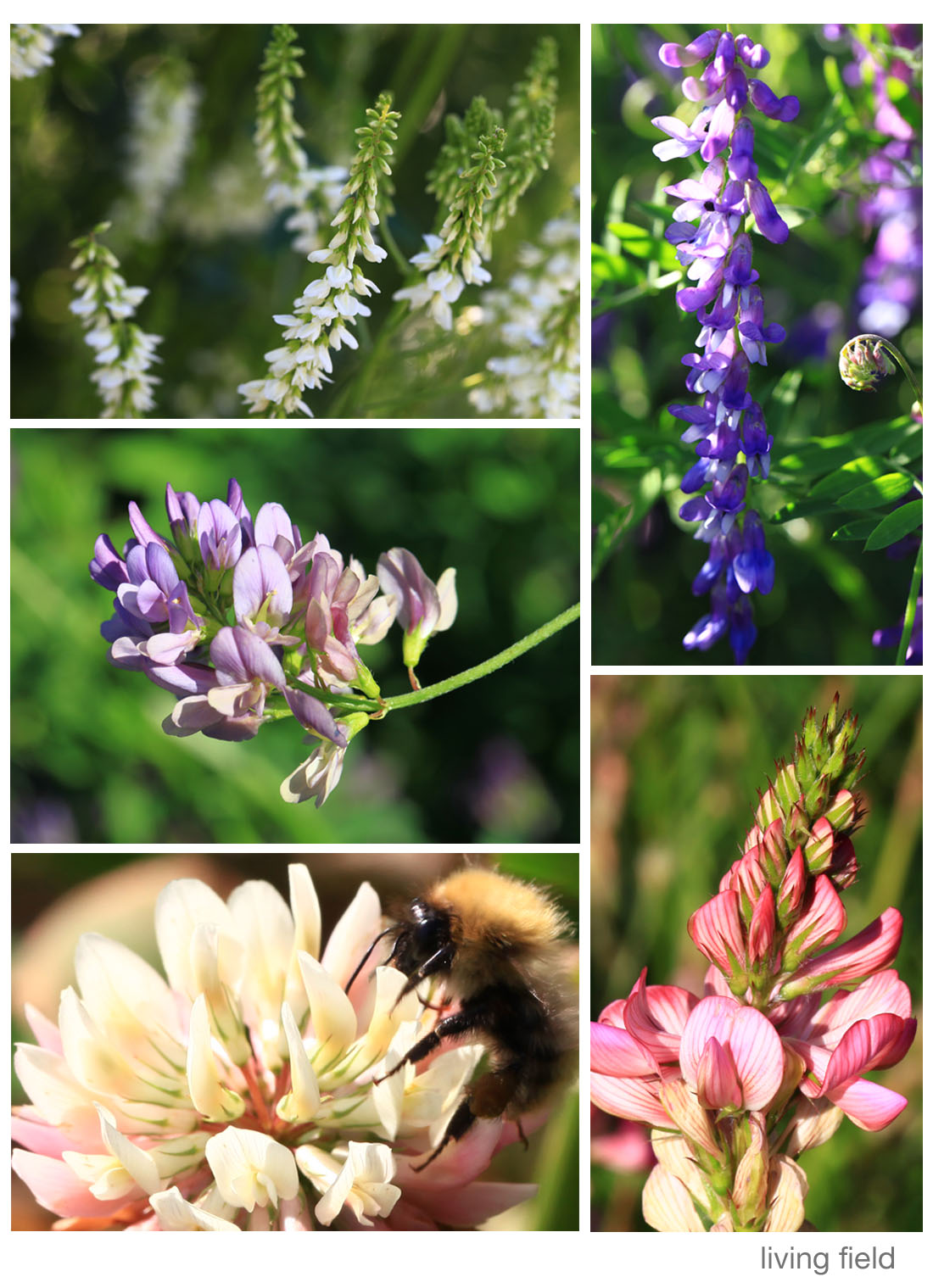
Chief among them are the nitrogen fixing legumes, offering high-nitrogen, high-protein take-away. The images (above, top left clockwise) show white melilot, the blue-flowered tufted vetch, sainfoin, alsike and lucern.
Only the tufted vetch is common in the margins and lanes here. The others have been tried as forages in the past but are now rarely found. Other legumes flowering (not shown) include red and white clover, the yellow-flowering melilot and greater bird’s-foot-trefoil, all well attended by bees.
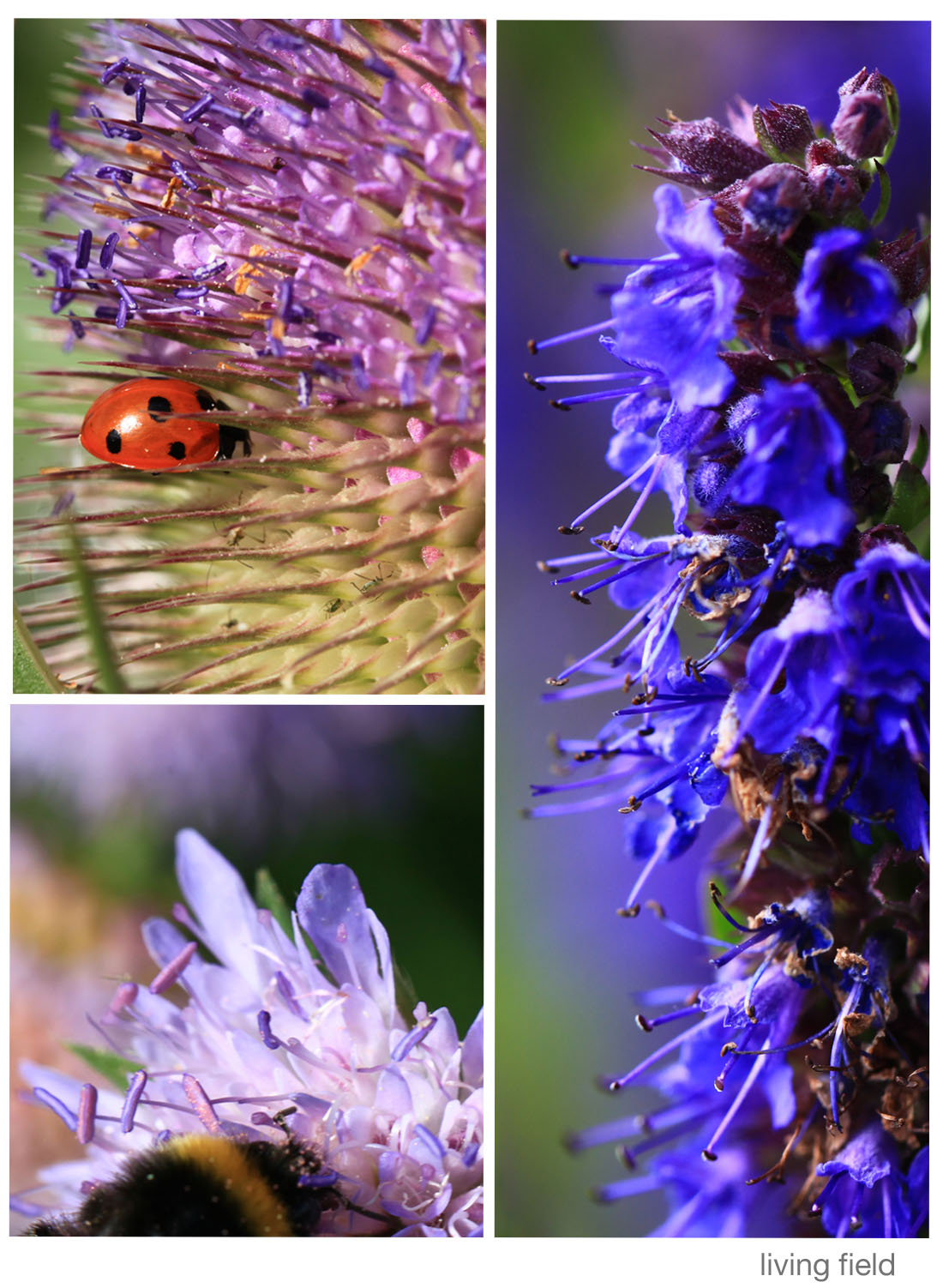
The other plants that most years offer months of rich flower-food fare no better.The striking, blue viper’s bugloss in the medicinals bed is almost finished bar a few, one of which is shown above right. And the remaining field scabious, bottom left above, will continue to put out their sumptuous floral parts for bees to drain and trash.
Yet again, the benefits of growing in this small space a diversity of native and medicinal plants pays, because teasel, knapweed and greater knapweed, and a set of annual composites including cornflower and corn marigold are all offering their wares in return for chance pollen.
Teasel will now flower along its bristly head for some weeks – the ladybird in the image top left above just slotting in between the spikes, jostling several aphids that may not be visible at this magnification.
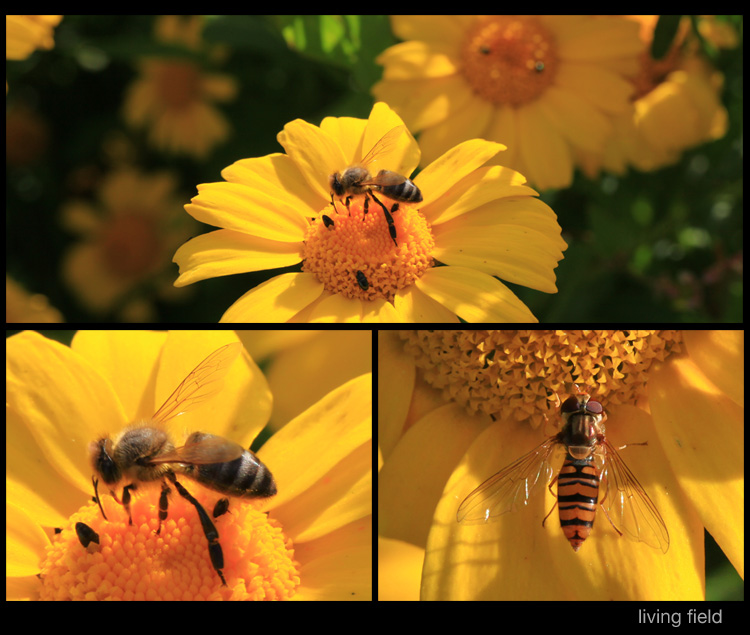
What’s to come – the deadnettle family – the labiates – will sustain the insects through to the autumn equinox. Many are only just in flower – betony, wild marjoram, some field mints, hemp-nettles, a calamint, sage, lemon balm and hyssop.
The restharrow Ononis repens is a tough plant, growing as it does at the very limits of dry, salty land around the coast. There it will fix nitrogen from the air, which finds its way through decomposition of roots and leaves into the sand and then perhaps to other plants and to soil microbes. It was also once a serious weed of cropland, as its name suggests, but a weed no longer, tamed by heavy ploughs and pesticide.
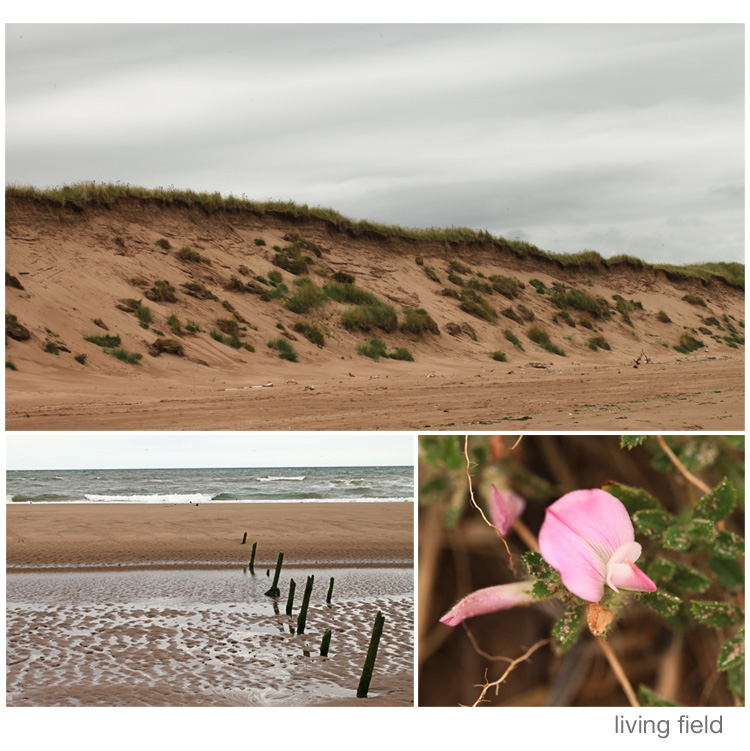
It grows well around the coasts of Angus and Moray. In Montrose bay, it grows in abundance, the main legume of the dunes. It is prolific near the south end, particularly around the car parks, binding the sand as it once slowed the harrow. To the north over the several miles of beach, it lives at the base of the collapsed dunes (images above), leaf and flower blasted by salt and sand grains.
In the images above, the line of stakes leading seaward from the dunes reaches out into the North Sea at its widest and after 650 km of rough water, meets the coast of Denmark. The restharrow is the first line of defence.
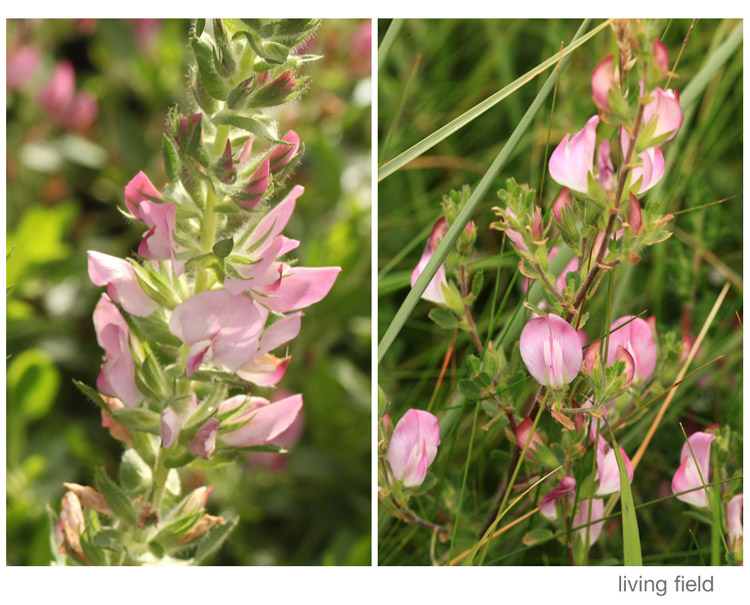
Grigson gives the mediaeval names of the plant, one of which resta bovis translates as ox-stop, and cites a treatise of 1578: ‘the roote is long and limmer, spreading his branches both large and long under the earth, and doth ofttimes let, hinder and staye, both the plough and oxen in toyling the ground’.
In her 1920 book, Winifred Brenchley classed restharrow Ononis repens among ‘coarse growing plants that deteriorate the quality of pasture or meadow’. And in the last century it seems to have been a problem in grass rather than in land that was repeatedly tilled.
Its decline from the community of common weeds is now so great that it is hardly found in farmland. Yet as recently as 1938, H. L. Long wrote “If this weed is plentiful it must be attacked by thorough and regular cutting, liming, complete manuring, and close depasturing with stock. In rare instances it may be desirable to plough up the pasture, give a thorough cleaning and manuring, and again lay down to grass.”
Long placed it in the top 30+ weeds of pasture, but did not always distinguish the spiny Ononis spinosa, which has a more southerly distribution in Britain, from Ononis repens which is the one shown here in the photographs and which was described by Long as having runners, usually spineless and with a strong disagreeable scent.
Grigson relates its presence in pasture as tainting milk, butter and cheese and children chewing its root, which gives it the name wild liquorice.
A few patches of restharrow remain in a remote corner of one of the Institute’s farms near Dundee.
To see what it looks like and how it grows, the Living Field garden keeps a small patch of it, originating from seed. Its luxuriant foliage and flowers grow to well over 0.5 m in height and attract a range of insect feeders. It is cut back to 10-20 cm above soil level in autumn, but is otherwise left to itself.
Its leaves and stems are softer in the garden, less wiry than at the edge of the North Sea (comparison above). There are also small variations in geometry of the leaves and sepals.
Brenchley WE. 1920. Weeds of farm land. Longmans, Green and Co, London. Grigson G. 1958. The Englishman’s flora. (Paladin, 1975). Long HC. 1938. Weeds of grass land. HMSO.
Note: on sampling the coastal plants, Euan James reports nodulation, indicating they are fixing nitrogen.
Contact/date: GS 30 July 2015.
Also on the web site:
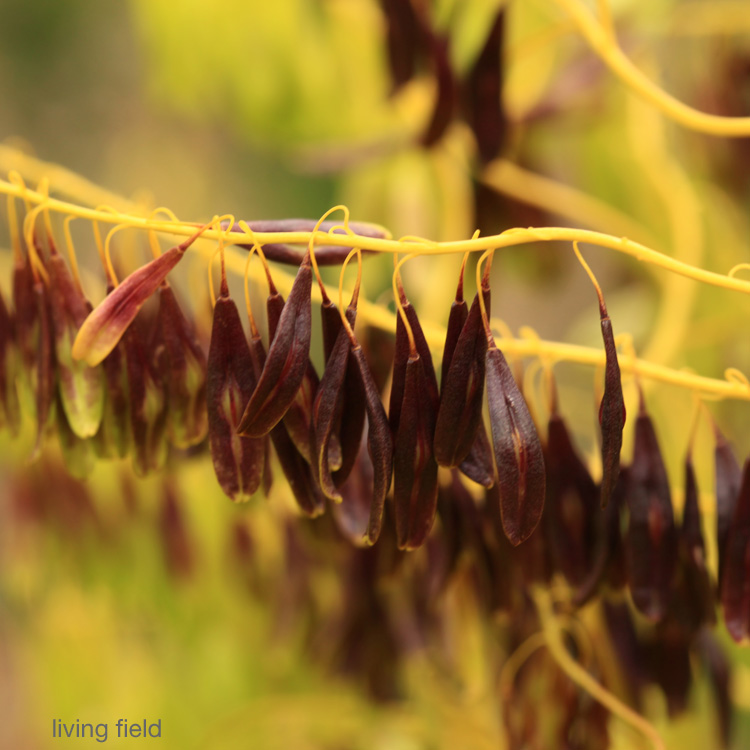
Another of the garden’s unusual plants attracting attention – NileHQ, a design company, commissioned a photographer from Dundee to take some images woad growing in the Living Field garden.
Woad flowers early in its second year. By late June, the yellow flowers are almost gone, while the pods, hanging in masses on the pale yellow floral branches, are turning from green to brown. In the next few weeks they will turn black and then the seeds are mature.
Woad reproduces in the garden from its own dropped seed. We thin and sometimes rearrange the plants in the summer of the first year.
Photograph above by the Living Field on 29 June 2015.
The kidney vetch Anthyllis vulneraria was noted in a recent post about nitrogen-fixers living by the shore on the east coast of Angus. But the kidney vetch has wider acclaim as host of the rare Small Blue butterfly Cupido minimus.
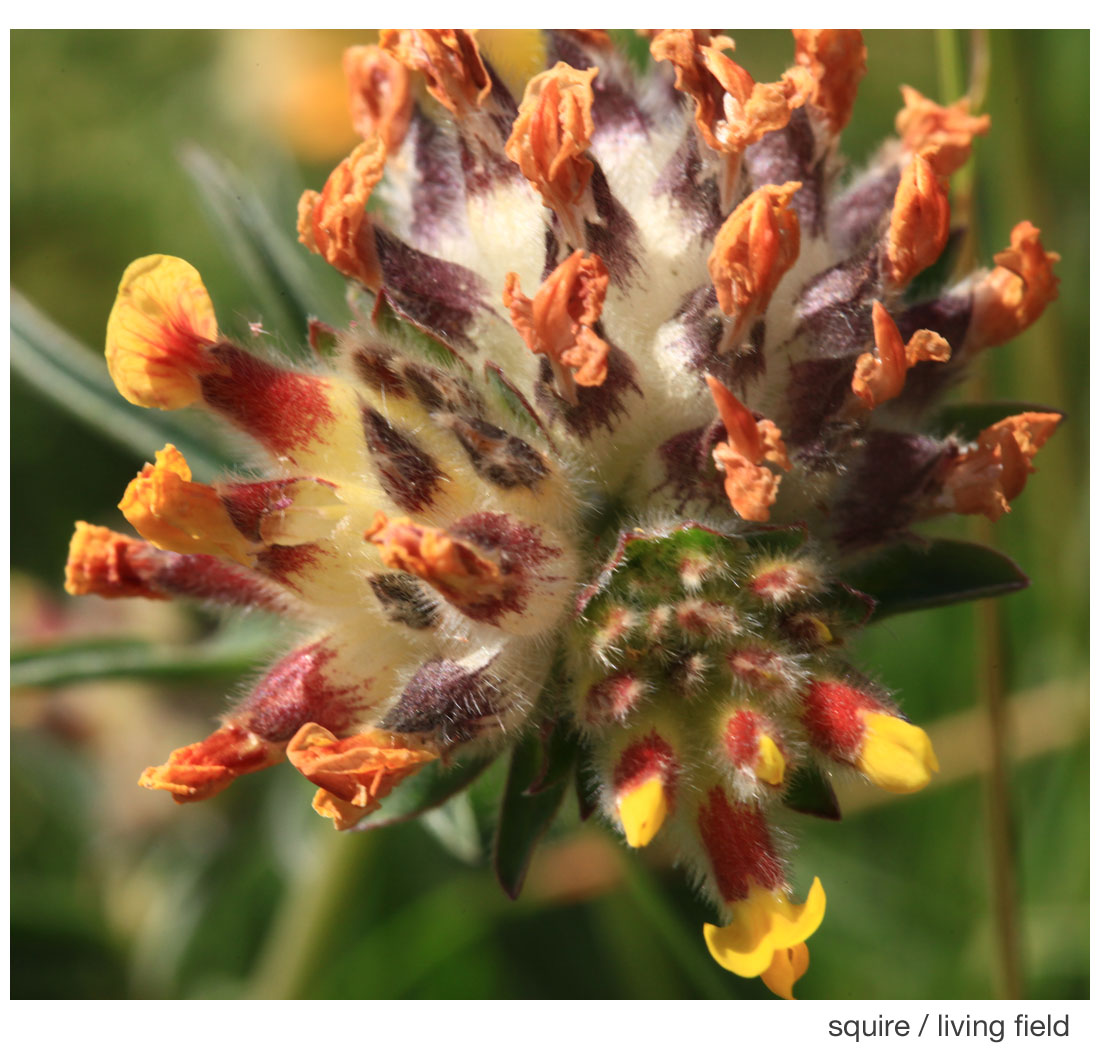
The small blue lays its eggs in the flowering heads of kidney vetch. The hatched larvae then eat the flowers and the developing seed.
However, the range of the butterfly in the north east has decreased in recent years and attempts are being made to record its occurrence. For more on the small blue and current surveys in Scotland –
In the latter can be found people to contact if you want to take part in surveys or to report sight of the butterfly.
The kidney vetch is one of the nitrogen-fixing legumes that occur in nitrogen-poor, dry and unshaded environments around the coast of eastern Scotland.
Yet it was once considered as a sown forage – a constituent of vegetation managed for stock-feeding. Lawson and Son (1852) write that it ‘does not yield much produce, but is eaten with avidity by horses, sheep and cattle, and also by hares and rabbits, and might therefore be introduced into mixtures for very dry soils’.
The Living Field garden grows kidney vetch in its medicinals collection and in the raised beds that have housed a legume collection over the past few years (images below). It grows well, forming luxuriant clumps up to 30 cm in height, taller than on the coast. The flowers are usually more yellow, less red than on the wild plants.
It flowers and seeds profusely in the garden. Some plants die in the winter, but in the last two years it has regenerated freely from its own dropped seed.
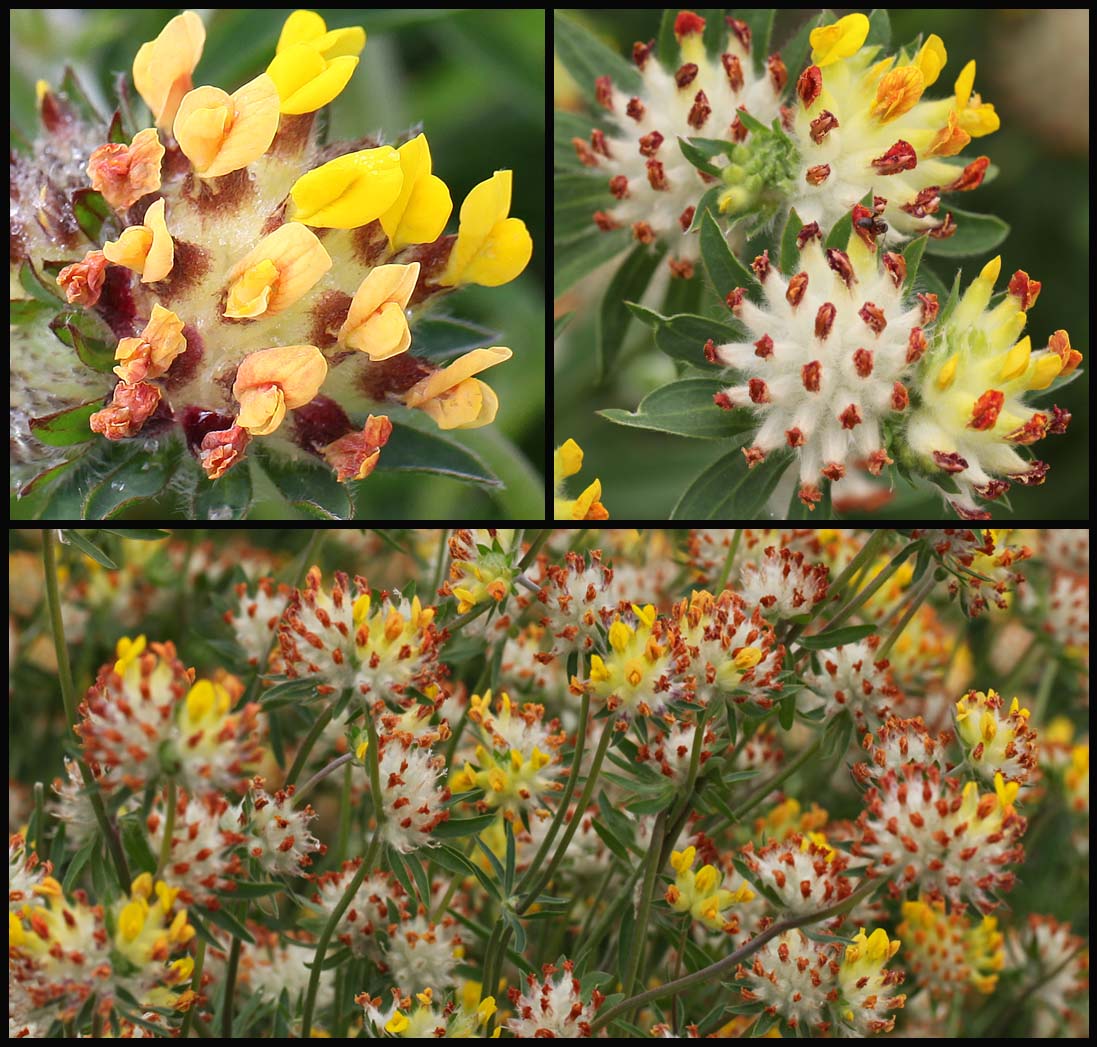
The round ‘wooly’ heads may be confusing at first sight, but each ball consists of usually three separate heads each holding many individual flowers. The three heads do not all flower at the same time.
In the image at the top of the page, the head to the lower right is the latest to flower – some flowers are still in bud while others have the fresh yellow petals emerging from the red calyx tube (which previously enclosed the bud). The head to the left has a mix of new and withered flowers. The largest one, at the top middle and right, has finished flowering: all petals are withered orange, the calyx tubes have turned purple and the hairs have expanded into a whitish mass, protecting the seeds that will form deep in the tubes.
Lawson and Son. 1852. Synopsis of the vegetable products of Scotland. Authors’ private press, Edinburgh.